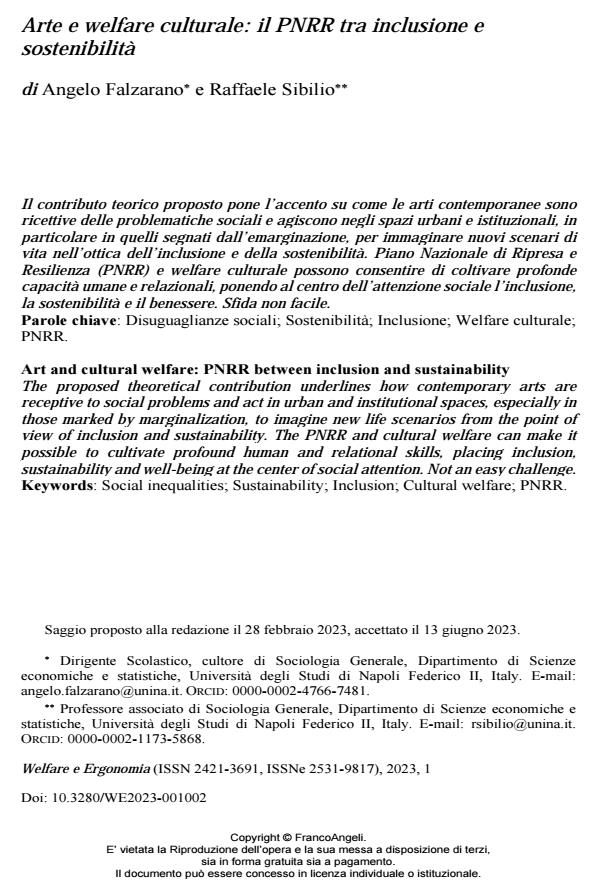Art and cultural welfare: PNRR between inclusion and sustainability
Journal title WELFARE E ERGONOMIA
Author/s Angelo Falzarano, Raffaele Sibilio
Publishing Year 2023 Issue 2023/1 Language Italian
Pages 10 P. 15-24 File size 325 KB
DOI 10.3280/WE2023-001002
DOI is like a bar code for intellectual property: to have more infomation
click here
Below, you can see the article first page
If you want to buy this article in PDF format, you can do it, following the instructions to buy download credits

FrancoAngeli is member of Publishers International Linking Association, Inc (PILA), a not-for-profit association which run the CrossRef service enabling links to and from online scholarly content.
The proposed theoretical contribution underlines how contemporary arts are receptive to social problems and act in urban and institutional spaces, especially in those marked by marginalization, to imagine new life scenarios from the point of view of inclusion and sustainability. The PNRR and cultural welfare can make it possible to cultivate profound human and relational skills, placing inclusion, sustainability and well-being at the center of social attention. Not an easy challenge.
Keywords: Social inequalities; Sustainability; Inclusion; Cultural welfare; PNRR.
- AladroVico E., Jivkova Semova D. e Bailey O. (2018). Artivismo: Un nuevo lenguaje educativo para la accion social transformadora. Comunicar, 26(57). -- Testo disponibile al sito: https://www.redalyc.org/articulo.oa?id=15856696001. DOI: 10.3916/C57-2018-01
- Antonovsky A. (1979). Health, stress and coping. San Francisco: Jossey-Bass.
- Bungay H. and Clift S. (2010). Arts on Prescription: A review of practice in the UK. Perspectives in Public Health, 130(6).
- Cicerchia A., Rossi Ghiglione A. e Seia C. (2020). Welfare culturale. Roma: Treccani. -- Testo disponibile al sito: https://www.treccani.it/magazine/atlante/cultura/Welfare.html.
- COM/2018/267 final. Comunicazione della Commissione al Parlamento Europeo, al Consiglio, al Comitato Economico e Sociale Europeo e al Comitato delle Regioni. Una nuova agenda europea per la cultura. Bruxelles.
- Corbin J.H, Sanmartino M., Hennessy E.A. and Urke H.B. (2021). Arts and Health Promotion. Springer, Cham. DOI: 10.1007/978-3-030-56417-9
- da Silva D.S., Horlings L.G. and Figueiredo E. (2018). Citizen Initiatives in the Post-Welfare State. Social Sciences, 7: 252.
- Grossi E. e Ravagnan A. (2013). Cultura e salute. La partecipazione culturale come strumento per un nuovo welfare. Milano: Springer-Verlag.
- Haylett C. (2003). Culture, Class and Urban Policy: Reconsidering Equality. A Radical Journal of Geography, 35: 55-73.
- ISTAT (2022). La situazione del Paese nel rapporto annuale.
- Jeon G.-R. (2017). A Study of Academic Research Trend on Arts and Cultural Education. The Journal of Cultural Policy, 31: 76-96.
- Kim M.S. (2012). A Prospect on Concept Mapping for Learning of Music Elements. Korean Journal of Research in Music Education, 41: 67-100.
- Mora H., Pérez-delHoyo R., Paredes-Pérez J.F. and Mollá-Sirvent R.A (2018). Analysis of Social Networking Service Data for Smart Urban Planning. Sustainability, 10(12), 4732.
- Mustacchi C. (2011). Sulla retta via non ci va nessuno. Riflessioni su arte, normalità, disabilità. Rivista per le Medical Humanities, 20: 40-46.
- OMS (2019). Health Evidence Network Synthesis Report 67. What is the evidence in the role of the arts in improving health and well-being? A scoping review.
- ONU (2015). A/RES/70/1. Transforming our world: the 2030 agenda for sustainable development. Resolution adopted by the General Assembly on 25 September.
- Parc J. and Moon H.C. (2019). Accumulated and Accumulable Cultures: A Case of Public and Private Initiatives Toward K-POP. Kritika Kultura, 32: 429-52.
- Parsons T. (1977). The Problem of Order in Society, and the Program of an Analytical Sociology. American Journal of Sociology, 83: 320-39.
- Sarti S. e Terraneo M. (2023). Studiare la salute. La prospettiva della sociologia. Roma: Carocci.
- Stuckey H.L. and Nobel J. (2010). The Connection Between Art, Healing, and Public Health: A Review of Current Literature. American Journal of Public Health, 100(2).
- Tanner M.D. (2020). An Inclusive Post‐COVID Recovery. Cato Institute, September 15. -- Testo disponibile al sito: https://www.cato.org/pandemics-policy/inclusive-post-covid-recovery.
- Trione V. (2022). Artivismo. Arte, politica, impegno. Torino: Einaudi.
- Van Oorschot W. (2007). Culture and Social Policy: A Developing Field of Study. International Journal of Social Welfare, 16: 129-39.
Angelo Falzarano, Raffaele Sibilio, Arte e welfare culturale: il PNRR tra inclusione e sostenibilità in "WELFARE E ERGONOMIA" 1/2023, pp 15-24, DOI: 10.3280/WE2023-001002